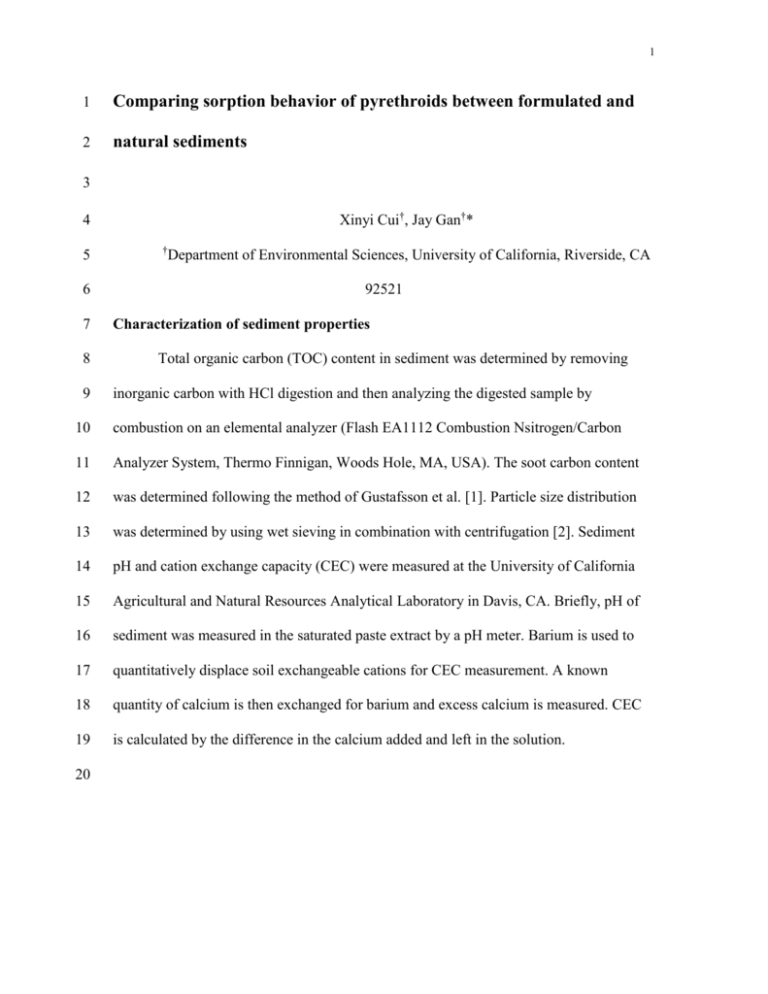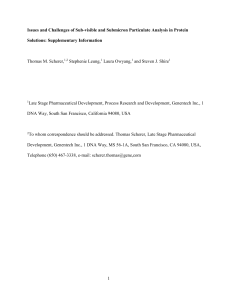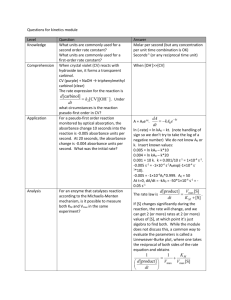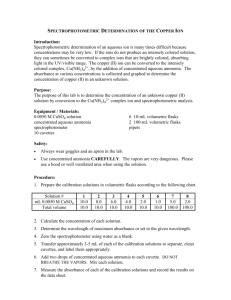etc2161-sup-0001-Data
advertisement

1 1 Comparing sorption behavior of pyrethroids between formulated and 2 natural sediments 3 Xinyi Cui†, Jay Gan†* 4 5 6 7 8 9 † Department of Environmental Sciences, University of California, Riverside, CA 92521 Characterization of sediment properties Total organic carbon (TOC) content in sediment was determined by removing inorganic carbon with HCl digestion and then analyzing the digested sample by 10 combustion on an elemental analyzer (Flash EA1112 Combustion Nsitrogen/Carbon 11 Analyzer System, Thermo Finnigan, Woods Hole, MA, USA). The soot carbon content 12 was determined following the method of Gustafsson et al. [1]. Particle size distribution 13 was determined by using wet sieving in combination with centrifugation [2]. Sediment 14 pH and cation exchange capacity (CEC) were measured at the University of California 15 Agricultural and Natural Resources Analytical Laboratory in Davis, CA. Briefly, pH of 16 sediment was measured in the saturated paste extract by a pH meter. Barium is used to 17 quantitatively displace soil exchangeable cations for CEC measurement. A known 18 quantity of calcium is then exchanged for barium and excess calcium is measured. CEC 19 is calculated by the difference in the calcium added and left in the solution. 20 2 21 22 Characterization of supernatant properties The dissolved organic carbon (DOC) content of the solutions was determined by 23 combustion of sample at 720°C on an Apollo 9000 total OC analyzer (Tekmar-Dohrmann, 24 Mason, OH, USA) after removing the inorganic carbon by acid digestion. The UV 25 absorbance of the supernatants at 254 nm was measured on a Shimadzu UV-1601 26 spectrophotometer (Shimadzu, Kyoto, Japan). The absorbance value (SUVA254), which 27 was previously shown to be related with aromatic carbon content of a DOC solution [3], 28 was determined by dividing the UV absorbance at 254 nm by the DOC concentration. 29 Meanwhile, the UV absorbance of the supernatants at 465 and 665 nm was also measured. 30 The ratio of absorbance at 465 and 665 nm (E4/E6) has been used as an empirical 31 indicator for aromaticity of humic materials [3]. 32 3 33 34 Figure S1. Image of sediments used. Left: Little Harbor Beach sediment; Right: 35 formulated sediment A 4 36 Table S1. Selected properties of supernatant solutions in the present study ABS254 (10-2) DOC (mg/l) E4/E6b pH a (L/mg/m) FSA 1.96 6.59 2.55 1.14 FSB 2.18 6.70 3.09 1.18 FSC 5.28 7.43 7.23 1.98 EMP37 1.94 5.45 2.66 1.18 EMP73 0.95 6.12 9.49 1.02 LHB 6.66 7.24 9.01 1.64 GCP 1.73 4.27 9.88 1.51 SC 1.60 6.76 1.23 1.04 37 a 38 254 nm by dissolved organic carbon (DOC) concentration of the supernatant. 39 b ABS254 means specific absorbance at 254 nm calculated by dividing the absorbance at E4/E6 is the ratio of absorbance at 465 and 665 nm. 5 40 Table S2 Distribution coefficient (Kd) values Cyfluthrin Cis-permethrin Kd-SPME Kd-app (104) Kd-SPME Ratioa Kd-app (104) 4 Kd-SPME Ratio Kd-app (104) 4 (10 ) 41 Trans-permethrin Ratio 4 (10 ) (10 ) FSA 0.40±0.12 2.89±1.42 8.5±6.9 0.16±0.066 1.69±0.25 12.1±5.5 0.14±0.062 9.56±2.67 76.7±38.4 FSB 1.46±0.19 3.51±1.32 2.4±0.6 1.20±0.18 2.34±0.71 1.9±0.5 1.13±0.10 3.83±1.65 3.4±1.3 FSC 1.67±0.33 3.32±0.81 2.0±0.3 1.12±0.26 1.66±0.18 1.5±0.4 0.94±0.12 1.75±0.32 1.9±0.3 EMP37 0.34±0.0080 17.06±6.96 52.8±27.8 0.097±0.010 13.52±5.92 144.3±80.0 0.10±0.0083 34.69±4.28 334.1±44.8 EMP73 4.56±1.10 6.31±1.40 1.4±0.1 2.58±0.17 3.7±0.3 LHB 0.11±0.031 16.06±12.28 140.5±67.2 0.11±0.029 GCP 3.63±2.54 6.36±2.93 23.3±13.2 SC 20.41±1.70 4.01±1.47 2.0±0.7 a Ratio of Kd-SPME over Kd-app. 4.28±1.13 1.7±0.5 2.46±0.28 8.98±1.11 11.07±5.23 97.7±23.6 0.12±0.034 18.03±12.15 142.1±59.3 0.39±0.23 9.64±3.52 30.9±17.4 0.51±0.15 18.33±0.60 31.4±5.6 11.87±1.64 2.23±0.58 1.9±0.3 1.03±0.23 3.97±1.50 4.0±2.0 6 42 Continuing with Table S2 Fenpropathrin Esfenvalerate Kd-SPME Kd-app (104) Kd-SPME Ratioa Kd-app (104) 4 44 Kd-SPME Ratio Kd-app (104) 4 (10 ) 43 Deltamethrin Ratio 4 (10 ) (10 ) FSA 0.089±0.030 0.30±0.076 3.6±1.2 0.26±0.14 12.93±5.33 57.3±27.8 0.22±0.11 4.61±1.57 26.6±15.8 FSB 0.39±0.041 0.60±0.17 1.5±0.3 2.03±0.20 8.56±5.40 4.1±2.2 1.89±0.22 6.20±3.83 3.2±1.7 FSC 0.25±0.083 0.26±0.058 1.1±0.2 2.48±0.35 8.15±2.24 3.3±0.6 2.46±0.19 5.07±0.89 2.1±0.2 EMP37 0.062±0.00092 2.84±0.64 45.6±10.7 0.13±0.016 72.86±24.66 587.2±260.6 0.091±0.0080 27.18±4.33 347.5±66.4 EMP73 0.68±0.099 1.14±0.23 1.7±0.3 4.47±0.82 LHB 0.12±0.034 2.53±0.97 21.1±3.3 GCP 3.56±2.03 3.70±0.78 12.4±5.4 SC 2.68±0.49 0.41±0.017 1.6±0.3 a Ratio of Kd-SPME over Kd-app. 13.62±3.75 3.0±0.5 3.57±0.91 17.29±3.35 5.0±1.4 0.19±0.068 26.13±15.17 129.3±32.3 0.18±0.061 16.12±1.73 130.1±43.7 0.35±0.25 6.42±4.40 24.0±16.0 0.33±0.23 8.35±2.83 2.14±0.19 10.66±3.08 4.9±1.0 2.05±0.12 10.73±6.02 5.3±3.2 36.3±22.8 7 45 Table S3. The fraction of freely dissolved concentration (Cfree) in total aqueous phase concentration (CW) (Cfree/CW, %) cisSediment 46 Bifenthrin trans- Fenpropathrin Cyhalothrin Cyfluthrin Permethrin Permethrin Esfenvalerate Deltamethrin FSA 11.85 30.28 8.50 9.40 1.54 17.92 1.89 4.80 FSB 66.20 67.49 53.96 53.47 32.7 44.01 28.81 36.69 FSC 86.30 77.24 54.94 67.77 54.7 51.05 31.32 39.72 EMP37 1.31 2.27 0.95 0.82 0.30 2.26 0.20 0.32 EMP73 85.75 60.76 70.30 62.90 27.50 72.20 33.60 20.91 LHB 2.10 4.81 2.02 1.06 0.78 0.81 0.81 0.96 GCP 26.56 9.64 11.69 4.67 3.23 6.29 7.12 4.69 SC 51.02 65.97 32.40 54.40 28.71 55.24 24.04 20.87 FS a 54.78 58.34 39.14 43.55 29.64 37.66 20.67 27.07 Natural 33.35 28.69 23.47 24.77 12.10 27.36 13.15 9.55 a FS and Natural are the average values for formulated and natural sediments. 8 47 48 REFERENCES 1. Gustafsson Ö, Haghseta F, Chan C, MacFarlane J, Gschwend PM. 1997. 49 Quantification of the dilute sedimentary soot phase: Implications for PAH speciation 50 and bioavailability. Environ Sci Technol 31:203-209. 51 2. Stemmer M, Gerzabeki MH, Kandeler E. 1998. Organic matter and enzyme activity 52 in particle-size fractions of soils obtained after low-energy sonication. Soil Biol 53 Biochem 30:9-17. 54 3. Korshin GV, Li CW, and Benjamin MM. 1997. Monitoring the properties of natural 55 organic matter through UV spectroscopy: Aconsistent theory. Water Res 31:1787- 56 1795.








